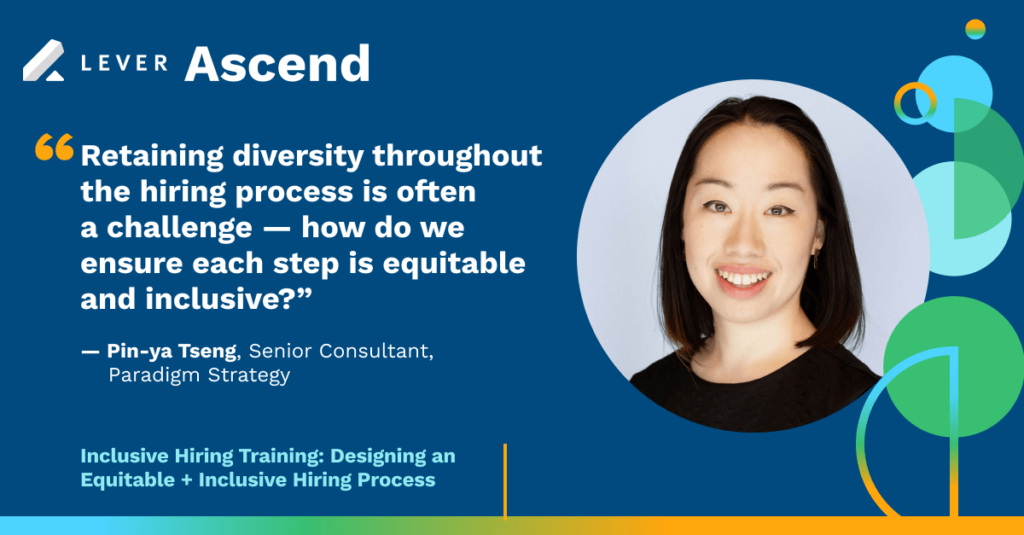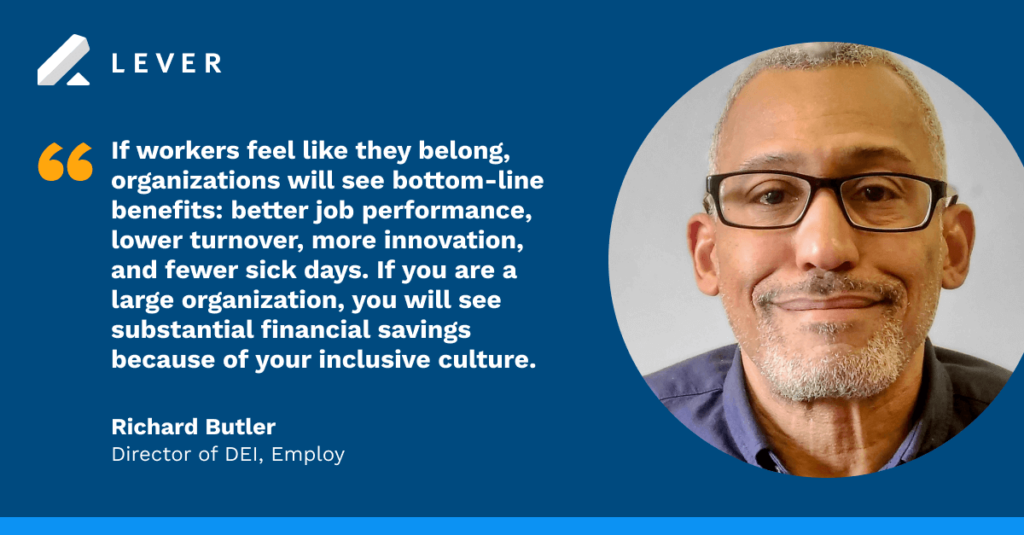Recruiters and hiring teams know the talent market better than anyone.
After all, you’re working to source, engage, and nurture talent every single day — not just new talent, but existing employees, too.
With this knowledge, you’re able to provide insights into things like job descriptions, salary expectations, competitor recruiting, internal mobility, and much more.
What about inclusivity, though?
From the perspective of diversity, equity, and inclusion (DEI), job descriptions can give further insight into organizational culture and a company’s approach to DEI. A job description gives candidates’ an inside at your org, so it needs to be highly inclusive.
A diverse workforce benefits all. It’s not just good for your business. It is good business.
Here are a few facts about diverse workforces that show why diversity recruiting is vital:
- 67% of business professionals consider workplace diversity an important factor when considering employment offers with a new company.
- Studies have found that anonymized recruiting can help increase the likelihood of hiring more diverse teams, up to 46% when hiring women.
- Companies with racially diverse teams across their org tend to outperform others lacking in diversity, with some performing up to 35% better.
For recruiters, ensuring that job descriptions and postings are inclusive is part of marketing your organization to top talent — but candidates appreciate it, too.
With that in mind, let’s take a look at how you can write truly inclusive job descriptions.

6 tips to write more inclusive job descriptions
It’s fair to say that diversity recruiting can have a substantial impact on the success of a company — and what better place to start than with your job descriptions?
We’re going to walk you through six tips to help you write inclusive job descriptions.
1) Address gender coding in all your job descriptions
Gender coding refers to signals, such as words, phrases, or traits, that have been historically associated with or attributed to either the male or female gender.
Gender coding occurs in recruiting messaging more often than you may think and can create a false impression as to who the ideal candidate is for a role.
It can be a tough pill to swallow, but if your job descriptions are ‘coded’ too heavily towards any gender, it can influence who does or doesn’t apply, effectively alienating talent right out of the gate — regardless of skills or qualifications.
By addressing gender coding first, you can better craft descriptions and job postings that don’t skew towards a specific gender, even unintentionally.
Take Hypercontext, for example. The company forgoes the traditional “fit” aspect to focus on inclusive language that welcomes all applicants, not just those from specific backgrounds, perspectives, or prescribed genders. As Sr. Marketing Manager Hiba Amin noted:
- “At Hypercontext, we approach job descriptions with internal mobility and external inclusivity in mind. For example, we include language that combats any apprehension candidates have, especially those who would be categorized as POC or womxn.
- “It’s no secret that minorities are less likely to apply to roles that they’re qualified (or nearly qualified) for because we find ways to convince ourselves that there are better candidates out there. That’s definitely been the case for me many times throughout my career.
- “So, to combat this we use excerpts like the following to ensure that our JDs are always inclusive both to internal employees and external candidates.”
Which leads us to our next point …

2) Use gender-neutral language in every job description
We talked about humanizing job descriptions earlier on in this guide, and the same lesson goes for the language you use in your descriptions.
While we all have preferred pronouns, leveraging gendered pronouns in job descriptions is a sure-fire way of excluding pools of candidates who may otherwise be qualified for the role.
For example, if you’re hiring a Sr. Developer, language like, “He will design, code, test, and implement our solutions” gives job seekers the impression that the role is male-centric.
Instead, “You will design, code, text, and implement our solutions,” helps you avoid gender bias while also giving the impression that you’re speaking directly to the candidate.
3) Use entirely inclusive language to promote openings
Gendered pronouns are not the only words that can subtly yet quickly deter candidates from applying to a role. How you phrase your job description can also have an impact.
For example, it’s not uncommon for certain terms or job titles (like that example of a “Rockstar” we used earlier) to signal male-dominated cultures, while seemingly harmless language like “ambitious” or “competitive” can alienate women candidates.
Being cognizant of how language can implicate bias towards certain groups or genders can help you avoid crafting discriminatory descriptions.

4) Forego job-related requirements and “must-haves”
The notion there’s a “perfect” candidate for every role is outdated and disregards a person’s ability to learn new skills, adapt to a new environment, and adopt knowledge as they go.
In reality, most of the “must-haves” listed in job descriptions are nice-to-haves or skills that can be learned while in a role. In the case of inclusivity, focusing too heavily on requirements or necessary skills/experience can alienate top candidates.
5) Remember that diversity includes disabilities, too
When focusing on making your job descriptions as inclusive as possible, don’t forget about candidates with physical and cognitive disabilities.
It’s not uncommon for a job posting to include language that’s inclusive of age, race, or gender, but exclusive of those with disabilities.
For example, stating that a candidate “Must be able to lift 50 pounds” is exclusive, while “Moves equipment up to 50 pounds” removes the “how” aspect and focuses instead on what needs to be accomplished in a role.
Ensure your job descriptions aren’t alienating talent with disabilities — seen and unseen.

6) Just drop the jargon in job listing copy altogether
Job descriptions littered with jargon (whether industry- or company-specific) can be problematic when sourcing talent from different avenues, especially outside of your industry.
Many candidates have transferable skills from other industries they may assume won’t convert based on the language you use.
A rule of thumb is to avoid using jargon altogether, but if you have to (e.g., if you’re hiring for a role that requires the use of specific tech or tool types), spell out things, acronyms, or describe the jargon in plain speak for candidates.
Discover how to write more effective job descriptions
It’s fair to say that, as a recruiter, you have a brief window in which you can capture a candidate’s attention and convert them from job seeker to applicant.
But how do you craft compelling descriptions that convert candidates?
In our exhaustive guide, we share our expert tips for creating impact descriptions, along with a template you and your talent team can start leveraging for your next best hire.



